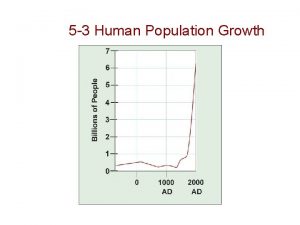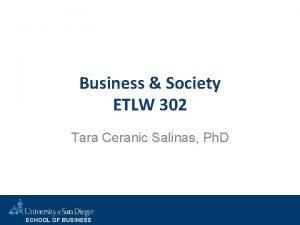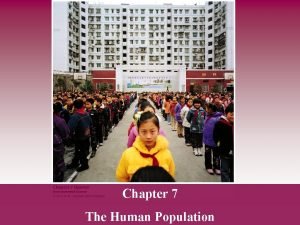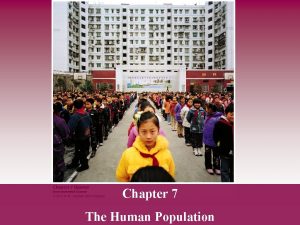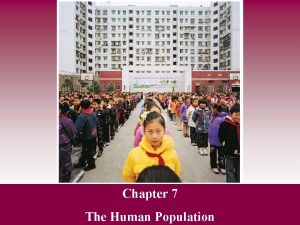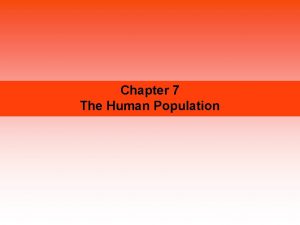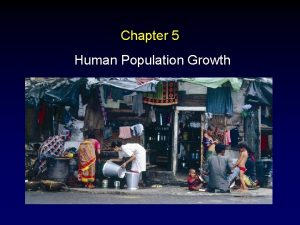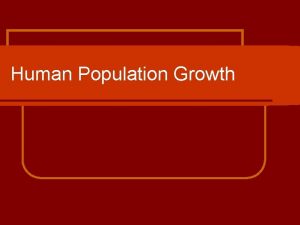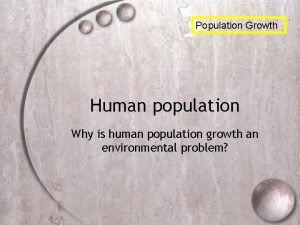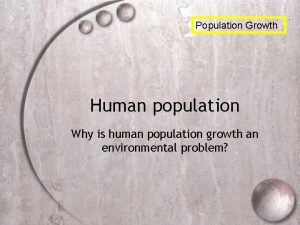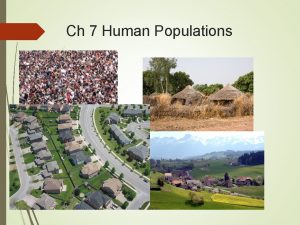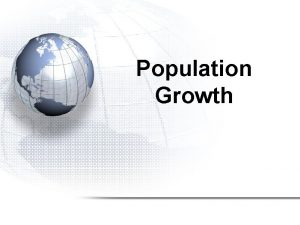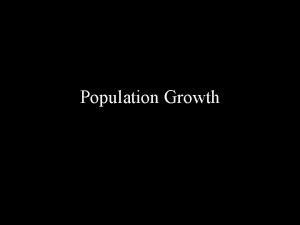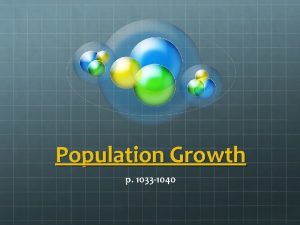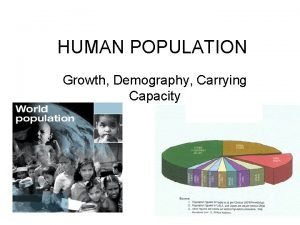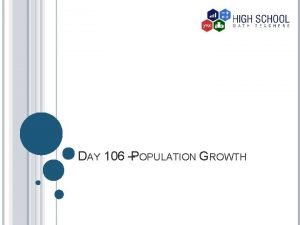Cha 7 Human Population Population Growth Scientists disagree





















- Slides: 21

Cha. 7 Human Population

Population Growth

Scientists disagree on Earth’s carrying capacity… A) Food surplus followed by a food deficit. Malthus believed in a fixed carrying capacity B) Technology allows food production to continually increase Increase in population = increase in intellect and innovation Creativity sets humans apart from most other species

Factors that drive human population growth… Demography- the study of human populations and population trends. Changes in Population Size Fertility Life Expectancy Age Structure Migration

Changes in Population size Immigration- the movement of people into a country Emigration- the movement of people out of a country. Net migration rate- the difference between immigration and emigration in a give year per 1, 000 people in the country.

Changes in Population Size Crude birth rate (CBR)= the number of births per 1, 000 individuals per year. Crude death rate (CDR)= the number of deaths per 1, 000 individuals per year. Global population growth rate = (CBR- CDR)/ 10 National population growth rate = (CBR+ immigration) - (CDR + emigration)/ 10 Doubling time (in years)- 70/growth rate

Fertility Total fertility rate- an estimate of the average number of children that each woman in a population will bear. Replacement level fertilitythe total fertility rate required to offset the average number of deaths in a population and for the current population size to remain stable.

Life Expectancy Life expectancy- the average number of years that an infant born in a particular year in a particular country can be expected to live, given the current average life span and death rate of that country.

Life Expectancy Infant mortality rate- the number of deaths of children under 1 year of age per 1, 000 live births. Child mortality rate- the number of deaths of children under age 5 per 1, 000 live births.


The Theory of Demographic Transition The theory of the demographic transition is theory that as a country moves from a subsistence economy to industrialization and increased affluence, it undergoes a predictable shift in population growth.


Phases of demographic transition… Phase 1: Slow population growth because there are high birth rates and high death rates which offset each other. Phase 2: Rapid population growth because birth rates remain high but death rates decline due to better sanitation, clean drinking water, increased access to food and goods, and access to health care. Africa and India Phase 3: Stable population growth as the economy and educational system improves and people have fewer children. Most countries have moved past phase 1 United States and Canada Phase 4: Declining population growth because the relatively high level of affluence and economic development encourage women to delay having children. Japan, UK, Germany, Russia, and Italy

Family Planning Family planning- the regulation of the number or spacing of offspring through the use of birth control.

Top 12 most populous countries

The relationship between economic development and population growth rate for developing nations.

Ecological Footprints Affluence - having a lot of wealth such as money, goods, or property.

IPAT equation To estimate the impact of human lifestyles on Earth we can use the IPAT equation: Impact= Population X Affluence X Technology

Urbanization

Urbanization

The impact of affluence… Gross domestic product (GDP)- the value of all products and services produced in a year in that country. GDP is made up of consumer spending, investments, government spending, and exports minus imports. A countries GDP often correlates with its pollution levels.
 Chao cha slide
Chao cha slide Cowboy cha cha line dance
Cowboy cha cha line dance Section 5-3 human population growth
Section 5-3 human population growth 5-3 human population growth
5-3 human population growth Good health is a choice agree or disagree
Good health is a choice agree or disagree Etlw
Etlw Mistakes are the portals of discovery essay
Mistakes are the portals of discovery essay Partly agree
Partly agree Agree disagree line
Agree disagree line Why historians disagree
Why historians disagree Agree strongly agree
Agree strongly agree Do you agree or disagree with the statement
Do you agree or disagree with the statement Do you agree or disagree with the statement
Do you agree or disagree with the statement Supernatural intervention archetype examples
Supernatural intervention archetype examples Growth analysis
Growth analysis Root hair structure
Root hair structure Growthchain
Growthchain Primary growth and secondary growth in plants
Primary growth and secondary growth in plants Vascular ray
Vascular ray Geometric growth graph
Geometric growth graph Neoclassical growth theory vs. endogenous growth theory
Neoclassical growth theory vs. endogenous growth theory Organic growth vs inorganic growth
Organic growth vs inorganic growth



